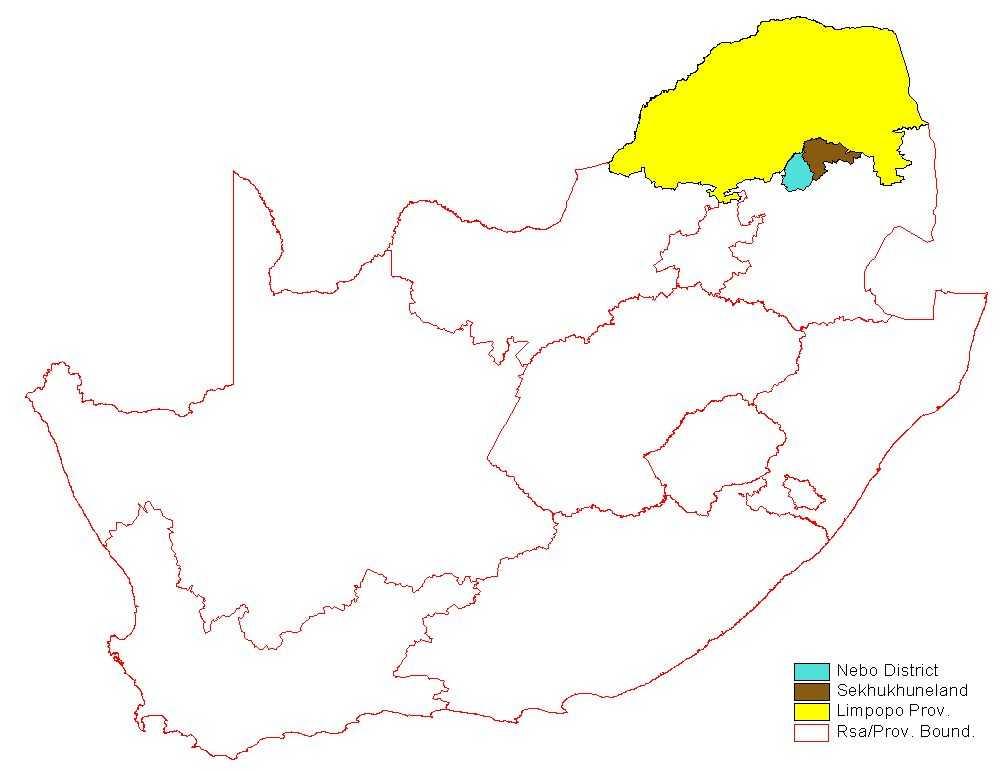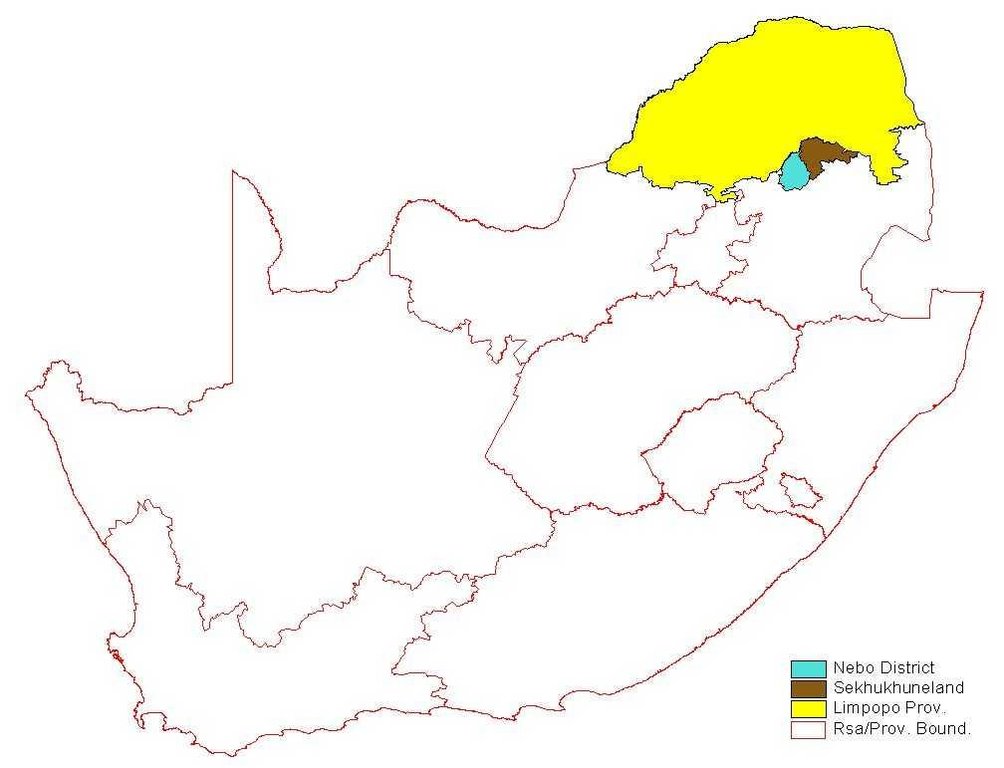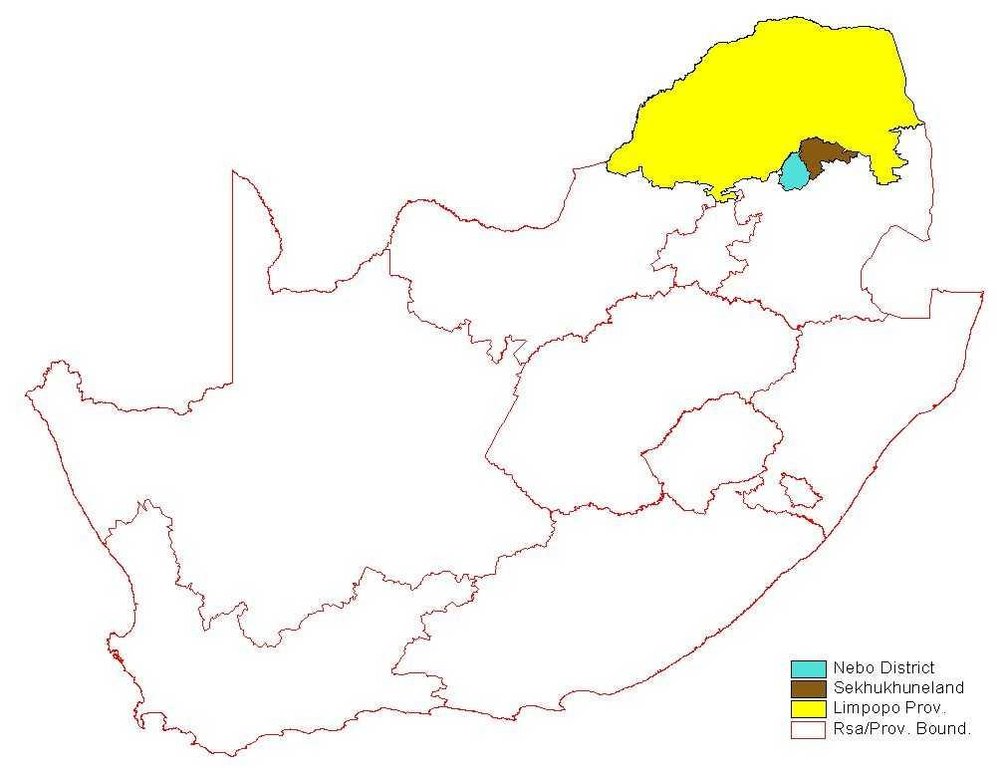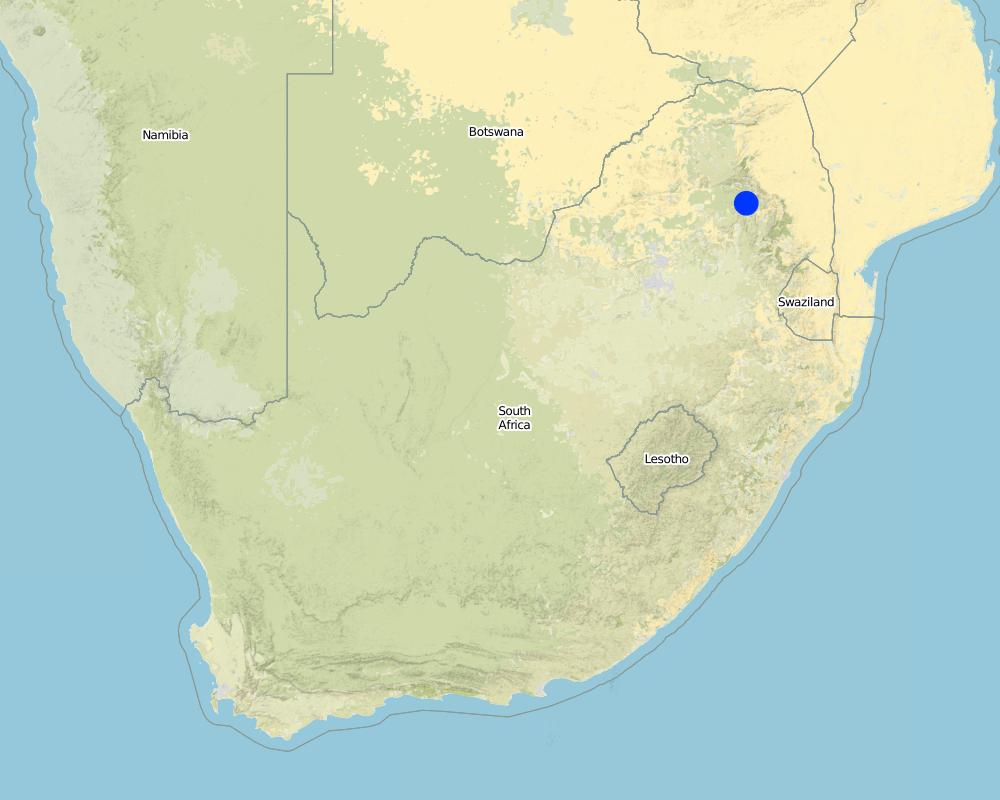Interactive community approach, biodiversity increase. [ប្រទេសអាហ្រ្វិកខាងត្បូង]
- ការបង្កើត៖
- បច្ចុប្បន្នភាព
- អ្នកចងក្រង៖ Igmé Wilhelm Terblanche
- អ្នកកែសម្រួល៖ –
- អ្នកត្រួតពិនិត្យ Fabian Ottiger
approaches_2415 - ប្រទេសអាហ្រ្វិកខាងត្បូង
ពិនិត្យមើលគ្រប់ផ្នែក
ពង្រីកមើលទាំងអស់ បង្រួមទាំងអស់1. ព័ត៌មានទូទៅ
1.2 ព័ត៌មានលម្អិតពីបុគ្គលសំខាន់ៗ និងស្ថាប័នដែលចូលរួមក្នុងការវាយតម្លៃ និងចងក្រងឯកសារនៃវិធីសាស្ត្រផ្សព្វផ្សាយ
ឈ្មោះអង្គភាពមួយ (ច្រើន) ដែលបានចងក្រងឯកសារ/ វាយតម្លៃលើវិធីសាស្ត្រផ្សព្វផ្សាយ (បើទាក់ទង)
Action Green Heritage (Action Green Heritage) - ប្រទេសអាហ្រ្វិកខាងត្បូង1.3 លក្ខខណ្ឌទាក់ទងទៅនឹងការប្រើប្រាស់ទិន្នន័យដែលបានចងក្រងតាមរយៈវ៉ូខេត
អ្នកចងក្រង និង(បុគ្គលសំខាន់ៗ)យល់ព្រមទទួលយកនូវលក្ខខណ្ឌនានាទាក់ទងទៅនឹងការប្រើប្រាស់ទិន្នន័យដែលបានចងក្រងតាមរយៈ វ៉ូខេត:
បាទ/ចា៎
1.4 ការយោងមួយ (ច្រើន) ទៅលើ (កម្រង) បញ្ជីសំណួរនៃបច្ចេកទេស SLM

Gully control (gabions) at Maandagshoek [ប្រទេសអាហ្រ្វិកខាងត្បូង]
Stone walls and re-vegetation (planting of indigenous trees) = Rehabilitation
- អ្នកចងក្រង៖ Igmé Wilhelm Terblanche
2. ការពណ៌នាអំពីវិធីសាស្ត្រផ្សព្វផ្សាយ SLM
2.1 ពណ៌នាសង្ខេបខ្លីពីវិធីសាស្ត្រផ្សព្វផ្សាយ
Community involvement
2.2 ពណ៌នាលម្អិតពិវិធីសាស្ត្រផ្សព្វផ្សាយ
ពណ៌នាលម្អិតពិវិធីសាស្ត្រផ្សព្វផ្សាយ:
Aims / objectives: Community involvement in SWC and environmental conservation. SWC project for erosion control, reduction of siltation, water conservation, biodiversity increase, and environmental education. An interactive method in some cases combined the approach of the Department or Action Green Heritage, who worked through the tribal chief (traditional authority), the relevant government representatives (extension), and the Transitional Local Council (TLC - Government elected body e.g. municipality). The SWC projects are still in the on-going phase, having passed the implementation stage. The Nature reserves are also on going (the development phase has been finalised). The SWC programmes of NGO and government extension officer, environmental education officer and community are interlinked with the NGO for funding, the Government provides technical background and the TLC ensures broad involvement.
2.3 រូបភាពនៃវិធីសាស្ត្រផ្សព្វផ្សាយ
2.5 ប្រទេស/តំបន់/ទីតាំងកន្លែង ដែលវិធីសាស្ត្រផ្សព្វផ្សាយត្រូវបានអនុវត្តន៍
ប្រទេស:
ប្រទេសអាហ្រ្វិកខាងត្បូង
តំបន់/រដ្ឋ/ខេត្ត:
Northern Province
Map
×2.6 កាលបរិច្ឆេទនៃការចាប់ផ្តើម និងបញ្ចប់នៃវិធីសាស្រ្តផ្សព្វផ្សាយនេះ
សូមបញ្ជាក់ឆ្នាំដែលបានបង្កើតឡើង:
1984
2.7 ប្រភេទនៃវិធីសាស្ត្រផ្សព្វផ្សាយ
- ផ្អែកលើគម្រោង/កម្មវិធី
2.8 គោលបំណង/ទិសដៅសំខាន់នៃវិធីសាស្ត្រផ្សព្វផ្សាយ
The Approach focused mainly on SLM with other activities (Nearby school involved environmental education for the school children, community, leaders (chiefs) and politicians involved)
Raising awareness, reduce silt soil loss. Nature reserve: financial gain for the community, protection of natural resources & increase biodiversity, awareness raising. Erosion projects: reduce siltation and soil loss and raising awareness. Natural Resource: Financial gain, protection of Natural Resources, an increase in biodiversity and raising awareness. To get community involvement in environmental issues
The SLM Approach addressed the following problems: Awareness, silt up of dams and rivers, land degradation (erosion) In nature reserves: land degradation, poverty, awareness, not sensitive enough for environmental problems. Erosion project: land degradation, siltation of dams/rivers. Nature Reserves: land degradation, poverty, awareness (lack of environmental knowledge)
2.9 លក្ខខណ្ឌអនុញ្ញាត ឬរារាំងការអនុវត្តន៍បច្ចេកទេសដែលស្ថិតនៅក្រោមវិធីសាស្រ្តផ្សព្វផ្សាយ
សង្គម/វប្បធម៌/ និងតម្លៃនៃសាសនា
- រារាំង
High population density - shortage of land - not always so easy to get land for building up nature reserve
Treatment through the SLM Approach: Awareness & project economic sustainable (that community can financially benefit)
ភាពអាចរកបាននៃធនធានហិរញ្ញវត្ថុ និងសេវាកម្ម
- រារាំង
Not enough funding
Treatment through the SLM Approach: Keep on looking for funding & generate a bigger awareness of the problem & what could be done, also outside of government like Olifant river forum (some people are there involved with a lot of funding behind them)
ក្របខណ្ឌច្បាប់ (សិទ្ធិកាន់កាប់ដីធ្លី កម្មសិទ្ធីប្រើប្រាស់ដីនិងទឹក)
- អំណោយផល
The existing land ownership, land use rights / water rights moderately helped the approach implementation: communal land if supported from tribal chief hinder: moderate: communal land if no ownership, a lot of people
ផ្សេងៗ
- រារាំង
Develop a project across a tribal border
Treatment through the SLM Approach: Environmental education
3. ការចូលរួម និងតួនាទីរបស់ភាគីពាក់ព័ន្ធ
3.1 អ្នកពាក់ព័ន្ធដែលបានចូលរួមក្នុងវិធីសាស្ត្រផ្សព្វផ្សាយ និងតួនាទីរបស់ពួកគេ
- អ្នកប្រើប្រាស់ដីក្នុងតំបន់/សហគមន៍
Action Green Heritage. People living in the area
In tribal meetings mainly men, for work mainly women. Chief will not take any decision before the community agreed
- អង្គការក្រៅរដ្ឋាភិបាល
- រដ្ឋាភិបាលថ្នាក់មូលដ្ឋាន
Provincial government
- រដ្ឋាភិបាលថ្នាក់ជាតិ (អ្នករៀបចំផែនការ អ្នកសម្រេចចិត្ត)
3.2 ការចូលរួមរបស់អ្នកប្រើប្រាស់ដីក្នុងតំបន់/ សហគមន៍ក្នុងតំបន់ក្នុងដំណាក់កាលផ្សេងគ្នានៃវិធីសាស្រ្តផ្សព្វផ្សាយ
| ការចូលរួមរបស់អ្នកប្រើប្រាស់ដីក្នុងតំបន់/សហគមន៍ក្នុងតំបន់ | សូមបញ្ជាក់នរណាត្រូវបានចូលរួម ព្រមទាំងពណ៌នាសកម្មភាពទាំងនោះ | |
|---|---|---|
| ការចាប់ផ្តើម/ការលើកទឹកចិត្ត | អសកម្ម | public meetings; Rapid/participatory rural appraisal is used today |
| ការរៀបចំផែនការ | អសកម្ម | rapid/participatory rural appraisal, public meetings |
| ការអនុវត្តន៍ | គ្មាន | |
| ការត្រួតពិនិត្យ និងវាយតម្លៃ | អសកម្ម | public meetings, reporting; |
| Research | គ្មាន |
3.4 ការសម្រេចចិត្តលើការជ្រើសរើសបច្ចេកទេស SLM
សូមបញ្ជាក់តើអ្នកណាជាអ្នកបានសម្រេចចិត្តក្នុងការជ្រើសរើសបច្ចេកទេសដើម្បីយកមកអនុវត្តន៍:
- អ្នកជំនាញឯកទេស SLM បន្ទាប់ពីបានប្រឹក្សាយោបល់ជាមួយអ្នកប្រើប្រាស់ដី
ចូរពន្យល់:
consultative.
Decisions on the method of implementing the SLM Technology were made by mainly by SLM specialists with consultation of land users. consultative.
4. ជំនួយបច្ចេកទេស ការកសាងសមត្ថភាព និងការគ្រប់គ្រងចំណេះដឹង
4.1 ការកសាងសមត្ថភាព/ បណ្តុះបណ្តាល
តើវគ្គបណ្តុះបណ្តាលបានផ្តល់ឱ្យអ្នកប្រើប្រាស់ដី/អ្នកពាក់ព័ន្ធផ្សេងៗទៀតដែរឬទេ?
បាទ/ចា៎
ទម្រង់នៃការបណ្តុះបណ្តាល:
- អនុវត្តន៍ជាមួយការងារ
ប្រធានបទបណ្តុះបណ្តាល:
On the site for work, fencing, gabions, planting of trees
4.2 សេវាផ្តល់ប្រឹក្សាយោបល់
តើអ្នកប្រើប្រាស់ដីបានទទួលនូវសេវាផ្តល់ប្រឹក្សាដែរ ឬទេ?
បាទ/ចា៎
ពណ៌នា/ពន្យល់:
Name of method used for advisory service: LEP; Key elements: NGO was responsible for education for the people of Lebowa; 1) Advisory service was carried out through: non-governmental agency. Extension staff: Government & NGO 2) Target groups for extension: land users, politicians/decision makers; Activitie
Advisory service is quite adequate to ensure the continuation of land conservation activities; They have the staff
4.3 ការពង្រឹងសមត្ថភាពស្ថាប័ន (ការអភិរឌ្ឍន៍អង្គភាព)
តើស្ថាប័នទាំងអស់ត្រូវបានបង្កើតឡើង ឬពង្រឹងសមត្ថភាពតាមរយៈវិធីសាស្ត្រផ្សព្វផ្សាយដែរ ឬទេ?
- បាទ/ច៎ា បានខ្លាំង
សូមបញ្ជាក់ថាតើស្ថាប័នត្រូវបានពង្រឹង ឬបង្កើតឡើងនៅត្រឹមកម្រិតណា(ច្រើន)?
- ថ្នាក់មូលដ្ឋាន
សូមបញ្ជាក់ប្រភេទនៃការគាំទ្រ:
- ហិរញ្ញវត្ថុ
- ការកសាងសមត្ថភាព/ បណ្តុះបណ្តាល
- សម្ភារៈ
4.4 ការត្រួតពិនិត្យ និងវាយតម្លៃ
តើការត្រួតពិនិត្យ និងវាយតម្លៃគឺជាផ្នែកមួយនៃវិធីសាស្ត្រដែរឬទេ?
បាទ/ចា៎
មតិយោបល់:
bio-physical aspects were ad hoc monitored through measurements
technical aspects were ad hoc monitored through observations
socio-cultural aspects were ad hoc monitored through observations
economic / production aspects were ad hoc monitored through measurements
area treated aspects were ad hoc monitored through measurements;
no. of land users involved aspects were ad hoc monitored through observations
management of Approach aspects were ad hoc monitored through observations
There were few changes in the Approach as a result of monitoring and evaluation: Involvement of the community in the project from the beginning to a great extent. Reduction of animal numbers.
5. ថវិកា និងសម្ភារៈឧបត្ថម្ភពីខាងក្រៅ
5.1 ថវិកាប្រចាំឆ្នាំសម្រាប់ផ្សព្វផ្សាយ SLM
ប្រសិនបើចំនួនពិតប្រាកដនៃថវិកាប្រចាំឆ្នាំមិនត្រូវបានដឹងច្បាស់ សូមប្រាប់ពីចន្លោះនៃថវិកានោះ:
- 100,000-1,000,000
មតិយោបល់ (ឧ. ប្រភពសំខាន់នៃមូលនិធិ/ម្ចាស់ជំនួយចំបង):
Approach costs were met by the following donors: government (national - Nature reserve): 80.0%; international non-government (-): 20.0%
5.2 ការគាំទ្រផ្នែកហិរញ្ញវត្ថុ / សម្ភារៈដែលបានផ្តល់ទៅឱ្យអ្នកប្រើប្រាស់ដី
តើអ្នកប្រើប្រាស់ដីបានទទួលការគាំទ្រផ្នែកហិរញ្ញវត្ថ/សម្ភារៈសម្រាប់ការអនុវត្តន៍បច្ចេកទេសដែរឬទេ:
បាទ/ចា៎
5.3 សូមបញ្ជាក់ពីធាតុចូលត្រូវបានផ្តល់បដិភាគ (រួមទាំងកម្លាំងពលកម្ម)
- សម្ភារៈ
| សូមបញ្ជាក់ ធាតុចូលណាខ្លះដែលបានផ្តល់បដិភាគ | កម្រិតទំហំប៉ុណ្ណា | សូមបញ្ជាក់ពីការបដិភាគ |
|---|---|---|
| ម៉ាស៊ីន | ផ្តល់ហិរញ្ញវត្ថុទាំងស្រុង | |
| ឧបករណ៍ | ផ្តល់ហិរញ្ញវត្ថុទាំងស្រុង | |
ប្រសិនបើកម្លាំងពលកម្មធ្វើដោយអ្នកប្រើប្រាស់ដី តើវាជាធាតុចូលដ៏សំខាន់មួយដែរ ឬទេ:
- បង់ជាសាច់ប្រាក់
5.4 ឥណទាន
តើឥណទានដែលបានផ្តល់នៅក្រោមវិធីសាស្ត្រផ្សព្វផ្សាយសម្រាប់សកម្មភាព SLM នេះយ៉ាងដូចម្តេច?
ទេ
6. ការវិភាគរកផលប៉ះពាល់ និងសេចក្តីសន្និដ្ឋាន
6.1 ផលប៉ះពាល់នៃវិធីសាស្ត្រផ្សព្វផ្សាយ
តើវិធីសាស្ត្រផ្សព្វផ្សាយជួយអ្នកប្រើប្រាស់ដីដើម្បីអនុវត្តន៍ និងថែទាំបច្ចេកទេស SLM?
- ទេ
- បាទ/ច៎ា បន្តិចបន្តួច
- បាទ/ច៎ា ជាមធ្យម
- បាទ/ច៎ា បានខ្លាំង
N/A
Did other land users / projects adopt the Approach?
- ទេ
- បាទ/ច៎ា បន្តិចបន្តួច
- បាទ/ច៎ា ជាមធ្យម
- បាទ/ច៎ា បានខ្លាំង
Personnel, some was transferred to other Departments and localities
6.3 សកម្មភាពផ្សព្វផ្សាយដែលប្រកបដោយចីរភាព
តើអ្នកប្រើប្រាស់ដីអាចធ្វើឱ្យមានចីរភាពនូវអ្វីដែលត្រូវបានអនុវត្តន៍តាមរយៈវិធីសាស្ត្រផ្សព្វផ្សាយដែរឬទេ(ដោយពុំមានការគាំទ្រពីអ្នកខាងក្រៅ)?
- មិនប្រាកដ
ប្រសិន ទេ ឬមិនប្រាកដសូមបញ្ជាក់ និងពន្យល់:
In practice maybe because of the need of financial support for staff and management of game Soil conservation - without leading it is not possible
6.4 ភាពខ្លាំង/ គុណសម្បត្តិនៃវិធីសាស្ត្រផ្សព្វផ្សាយ
| ភាពខ្លាំង/ គុណសម្បត្តិ/ ឱកាស ទស្សនៈរបស់អ្នកប្រើប្រាស់ដី |
|---|
| financial |
| job opportunities |
| are part of the management |
| ភាពខ្លាំង/ គុណសម្បត្តិ/ ឱកាស ទស្សនៈរបស់បុគ្គលសំខាន់ៗ |
|---|
| involvement of community |
| ownership of the land |
| little damage & high potential |
| get financial benefits - uplifting living-standard |
| sustainable jobs, protection |
| if transferred to community - can be financed from outside e.g. Development bank, this is only possible if fully transferred to the community |
6.5 ភាពខ្សោយ/ គុណវិបត្តិនៃវិធីសាស្ត្រ និងរកដំណោះស្រាយ
| ភាពខ្សោយ/ គុណវិបត្តិ/ ហានិភ័យ ទស្សនៈរបស់អ្នកប្រើប្រាស់ដី | តើបច្ចេកទេសទាំងនោះបានដោះស្រាយបញ្ហាដូចម្តេច? |
|---|---|
| would like to have more influence in the management |
| ភាពខ្សោយ/ គុណវិបត្តិ/ ហានិភ័យក្នុងទស្សនៈរបស់បុគ្គលសំខាន់ៗ | តើបច្ចេកទេសទាំងនោះបានដោះស្រាយបញ្ហាដូចម្តេច? |
|---|---|
| Smaller reserves are overstaffed and poor management - transfer to the community and then employ a manager from outside (may be a solution). | |
| Nature reserves are still regarded as government nature reserves (financial and run). Only if community is to some extent involved in the management, people take ownership. |
7. ឯកសារយោង និងវេបសាយ
7.1 វិធីសាស្ត្រ/ ប្រភពនៃព័ត៌មាន
- តាមការចុះទីវាល ការស្រាវជ្រាវនៅទីវាល
- ការសម្ភាសន៍ជាមួយអ្នកប្រើប្រាស់ដី
ការតភ្ជាប់ និងម៉ូឌុល
ពង្រីកមើលទាំងអស់ បង្រួមទាំងអស់ការតភ្ជាប់

Gully control (gabions) at Maandagshoek [ប្រទេសអាហ្រ្វិកខាងត្បូង]
Stone walls and re-vegetation (planting of indigenous trees) = Rehabilitation
- អ្នកចងក្រង៖ Igmé Wilhelm Terblanche
ម៉ូឌុល
គ្មានម៉ូឌុល





